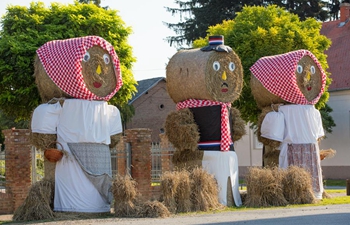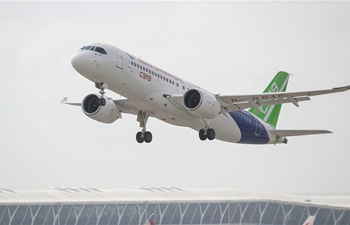by Cristobal Chavez Bravo
SANTIAGO, July 15 (Xinhua) -- A Chilean company is busy bringing vinyl records back to life after they disappeared from this South American country more than 35 years ago.
The vinyl record had been a mainstay in this country since 1951 when it made its debut as the great sound invention of modern times in the form of the "LP" or long play record.
But Vinyl factories ended up being dismantled in 1983, after succumbing to the arrival of the cassette.
Since the late 1980s not a single label was interested or even dared to once again manufacture vinyl records in Chile. And like in many other places, vinyl became more of a collector's item than a go-to choice for music.
However, a small group of young people clung tight to this form of musical reproduction, and in 2015 they dared to open a factory where vinyls would once again be produced.
"We knew that in Chile there was already a tendency to acquire physical formats that obviously disappeared many years ago," Patricio Gomez, commercial manager for Libre Records told Xinhua.
He said physical formats are naturally lost in a digital era. But romanticism for vinyl led to an upswing in the format which artists took advantage of to edit in microgroove and 33 RPMs.
In the commune of La Reina, an area that is within a stone's throw of the Andes, the machinery needed to produce vinyl was set up.
Inside the factory, there is a boiler, that fluctuates between 150 and 170 degrees Celsius, which sends the steam needed to heat the mold and plastic.
The steam flows to the pressing machine that will transform a piece of plastic into a work of art.
In the pressing machine, which is from the United States and dates to 1976, a mixture of polyvinyl chloride or PVC, vinyl acetate and antistatics are combined.
The mixture resembles a cluster of stones, that seemingly only an act of magic could transform into a vinyl record.
In this form, the PVC becomes a paste that will be poured into a mold where it is compacted and given shape to a disc.
The entire process is automated, from the transformation of the paste to sticking the label in the middle of the disc, just like a musical kitchen.
Gomez said this physical format "allows a direct relationship with the artist."
"Through the covers, the songs and the images - you materialize all that through a project like this," Gomez said.
In addition to Libre Records, there are factories in Argentina and Brazil, the only countries in South America that have returned to making vinyl.
While Latin America is about five years behind what is happening in the United States and Europe in terms of the increase in the sales of vinyl, representatives of Libre Records expect the upswing in vinyl sales to remain for some time.
"There are numerous themes that have to do with romanticism, with the current trend, with the decorative and with the collectibility of the format. What attracts people is the physical aspect," Gomez said.
In June 2017, the Japanese firm Sony announced it would once again begin manufacturing vinyl records. It had ceased production in 1989.
In fact, Discogs, one of the most important internet sites for information storage and sales of physical music, said that nearly 8 million vinyl records were sold in 2017, an increase of 18.81 percent from the previous year.
Diego Ili, director of Libre Records, said by manufacturing vinyl they transmit emotions.
"It's strange that today a group can debut a record without thinking of having to edit it in vinyl," Ili said.
And from the looks of it, the 33 RPMs needed for a vinyl to make sound, will stay in Chile for quite some time.
Libre Records will continue helping this format connect to new generations from its "kitchen," the same generations that saw vinyl as something from the past but that today is more sought after than ever.

















